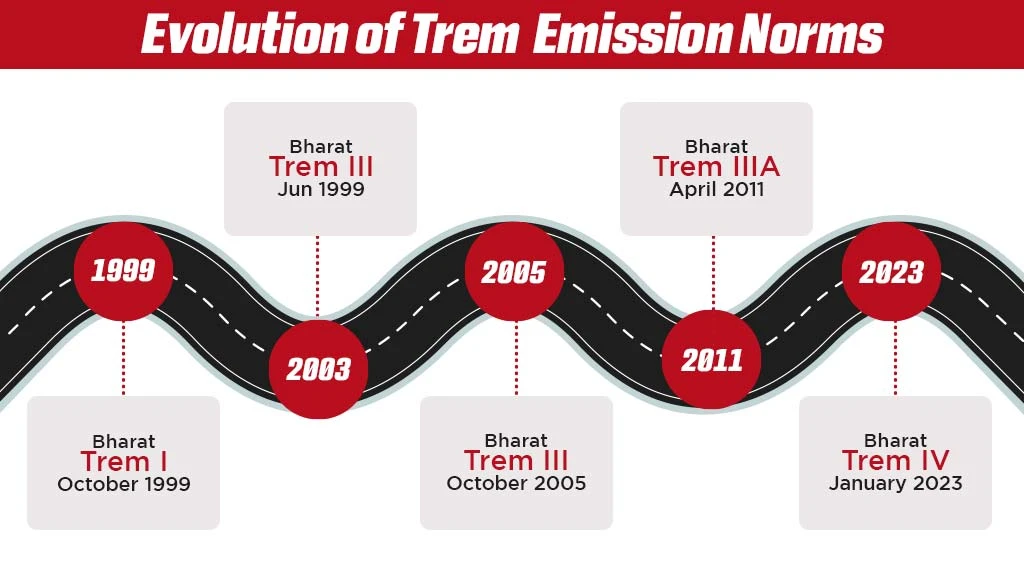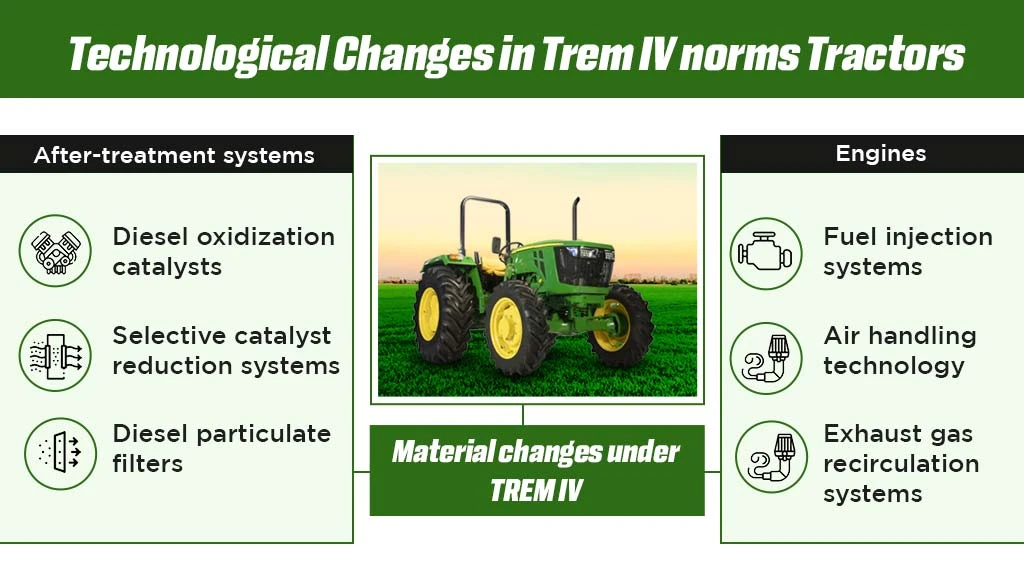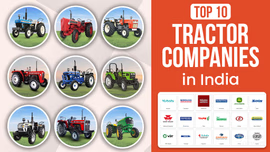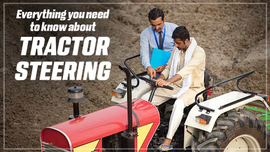Understanding Trem IV Emission Norms: Realities & Challenges for Farmers

Table of Contents
- Introduction
- Evolution of Emission Standards for Tractors in India
- What are Trem IV Emission Norms?
- What are the Anticipated Impacts of Trem IV Emission Norms?
- What are the Challenges to Implementation of Trem IV Emission Norms?
- The Way Forward
Introduction
Diesel tractors dominate farm mechanisation in India, with over 8.8 lakh units registered in 2024, accounting for 3.57% of total vehicle population in the country. The use of diesel tractors contributes 7.4% to the annual fuel consumption of India and a whopping 60% to the annual fuel consumption in the agriculture sector.
Furthermore, medium-size tractors of 21 – 40 HP engines have dominated the Indian tractor market; however, the market share of these tractors has decreased to 50% from 80% in recent years. There has been a perceptible shift in market share towards bigger tractors of 40+ HP engines.
Due to the increase in the use of diesel tractors with larger HP engines, the emission of Greenhouse Gases (GHG), particularly Particulate Matter 2.5 (PM2.5), Nitrogen Oxide (NOx) and Carbon Oxide (CO), is on the rise. In 2019, the agriculture sector contribution to GHGs was 14%. This necessitated stringent emission norms for agricultural tractors in India. As of today, India has implemented Bharat Trem Stage IV emission norms for agricultural tractors.
Evolution of Emission Standards for Tractors in India

The rise in vehicular emissions contributing to air pollution necessitated the introduction of Bharat Stage (BS) emission norms in India in April 2000. These norms were based on the recommendation of Dr. R A Mashelkar Committee. However, the emission standards for tractors in India started in October 1999 with the implementation of Bharat Tractor Emission (Trem) Stage I norms. Since then, India has tightened the emission norms for diesel tractors.
The Trem II emission standards set PM emission limits in 2003. Trem – III, implemented in 2005, further tightened the emission limits. The Trem III A, implemented in 2010 and 2011, for the first time set emission limits as per engine size. The stricter norms were set for tractors with 50+ HP engines.
With the introduction of Trem IV emission norms in January 2023, the emission limits for 50+ HP engine tractors have been further tightened.
What are Trem IV Emission Norms?
Bharat Trem Stage IV emission norms follow EU Stage IV norms, and it came into effect in January 2023. These norms were based on the recommendation of Mr. G R M Rao Committee. Some of the salient features of these norms are:
- It is applicable to all tractors with above 50 HP engine.
- It separated emission norms for agricultural tractors (Trem) and construction equipment vehicles (CEV).
- It also mandated stricter emission rates for PM (less than 0.1 gram/ kWh) and NOx (4 gram/ kWh)
- Even the sulphur content in diesel was limited to 50 parts per million (ppm).
- It brought material changes in engine and after-treatment systems in the form of CRDI fuel pump, cooled exhaust gas recirculation systems, and diesel oxidization catalysts.
What are the Anticipated Impacts of Trem IV Emission Norms?
Impact on PM and NOx Emissions
The anticipated impact on the emission of PM and NOx would depend upon the pace of expansion of the tractor market in India and the applicability of Trem IV norms.
As per estimates, the tractor market, in all likelihood, will continue to expand in the next two decades at 7% per annum. On the other hand, Trem IV norms only apply to above 50 HP tractors, which only form 7-8% of the overall tractor volume compared to 31 – 50 HP tractors, which constitute 70% of the volume and are responsible for two-thirds of the emission. As a result, PM and NOx will continue to rise, though at a slow pace.
Impact on Farmers
Implementation of Trem IV emission norms will push up the owning and operation cost for the farmers in India on account of the introduction of advanced electronics, sensors and The transition to upgraded emission norms will increase the cost of tractors above 50 HP by 10 – 15%, that is, it will increase by INR 1 – 1.30 lakhs.
Furthermore, it will also increase the cost of purchase and cost of maintenance for price-sensitive farmers. This, in turn, will substantially impact the goal of doubling the farmer’s income.
Impact on Tractor Manufacturers
Tractor manufacturers will have to realign their product portfolios. They will offer higher torque for lower HP tractors. It will also lead to a shift in the HP-wise mix. As a result, 41-50 HP category tractors will gain at the expense of above 50 HP category tractors.
They will also have to make huge investments to establish infrastructural support and well-established service network for pan-India penetration.
The fuel efficiency criteria, cost of ROPS and noise reduction norms, along with the above two factors, will likely increase the cost significantly for OEMs, which they will gradually pass on to the farmers in the form of hiked prices.
Impact on Farm Mechanisation
The tractor market is highly price-sensitive and yet quite brand-conscious. So, with the increase in cost, the impact on higher HP tractors will be greater. But the reality is that we need tractors above 50 HP for entire post-harvest and productivity-driven applications. This will impact the farm mechanisation target, which is already low at 47% compared to countries like Brazil (75%) and China (60%).
What are the Challenges to Implementation of Trem IV Emission Norms?

Technology Specific to Indian Conditions
Trem IV compatible technology will have to be suitable to India-specific conditions, which include wet land puddling, rampant contamination of fuel and usage of tractors without hoods, among others.
Socio-economic Conditions of Farmers
Unpredictable climatic impact and policy decisions at both the Centre and State governments will accentuate the already lopsided socio-economic conditions of Indian farmers. Farmers are already in distress; the adoption of upgraded emission norms will aggravate it by increasing the cost.
Acceptability of Tractors with Advanced Fuel Injection Systems
There exists a poor history of acceptability of rotary pump and turbo charger in the Indian context and the preference for naturally aspirated engine and inline fuel injection pump by farmers. Farmers are looking for products that can withstand Indian conditions. They prefer tangible benefits and reliable products.
Non-existence of Re-fuelling Stations
Due to the non-existence of re-fuelling stations in the close vicinity of farmers, they store fuel, leading to fuel contamination and fuel adulteration is another problem. So, we need to provide ‘abuse-proof’ product and fuel needs to go to farmers.
Slow Implementation of Emission Norms
India has been lagging developed markets when it comes to the implementation of stricter emission norms for tractors. The upgraded emission norms for the above 50 HP tractors were initially slated to be implemented in October 2020. However, the transition was deferred multiple times, finally coming into effect in January 2023.
The Way Forward
The Trem IV Emission Norms have come into effect for tractors above 50 HP, which meagrely forms 7 – 8% for the total tractor volume produced in the country. It means 80% of tractors are still following less stringent Trem III A norms. The government could mandate stricter Trem IV emission norms for 31 – 50 HP tractors also. Further, while implementing it, the government needs to ensure that it does not impact farmers cost-wise too much and does not derail the objectives of farm mechanisation and doubling farmer’s income. Moreover, in light of Trem V emission norms to be implemented in 2026, the government could start creating awareness among farmers about the benefits so that they accept stricter emission norms and contribute to greener agriculture.


Related Blogs












